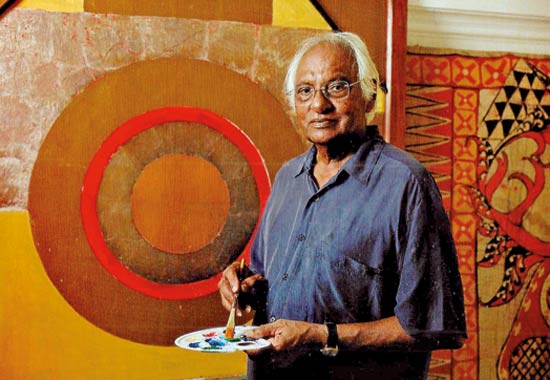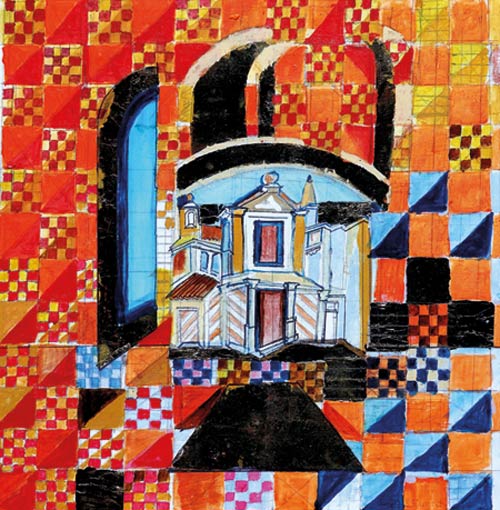Tracing his trajectory as an artist
Throughout my career I experimented with various materials – paper, wood, metal, glass and stone. I used different mediums – pen and ink, pencil, water colour, oils, acrylic and gold leaf. This required me to develop the skills of an engraver, lithographer, batik designer, gold leaf applier and more. I consider myself as an artist with a contemporary approach but my work is embedded with traditional and classical iconography and images.

Portrait of the artist
In this new exhibition, I wanted to present my more recent work while tracing my trajectory as an artist. Looking at the themes represented in my work, it is evident that I draw from my multiple interests and passions. The subjects relate to issues I have a profound interest in, and that I also conduct research on. Art at a personal level serves as a means of recording. Innumerable notebooks are filled, also annotated with inscriptions– the breeding plumage of bird or a unique architectural feature of a fort. The art work is most often an extension of this recording.

Cathedral in the square
As artists we crave to be unique but it is difficult to dismiss the multiple influences that shape our approach. My very first work presented in public was in 1958 as a 16-year-old. I submitted an oil painting for an exhibition at the Ceylon Society of Art, which was listed in the Special Mention category. The painting depicted a locomotive, caught in a screen of steam and smoke, approaching the main railway station at Fort. The theme was based on a painting by Claude Monet (1840-1926) in 1877 of a train entering the Gare Saint Lazare in Paris. As a teenager I was fascinated by the French Impressionist School, though it was some two decades later that I was able to visit Paris and other centres of Western art including Moscow and New York to see the work of the artists who intrigued me. The various modern schools of art challenged my own approach.
My work draws from more classical approaches to and scientific uses of art. For instance, my passion for archaeology and classical art both Eastern and Western have provided me with rich source material. During my visits to historical sites and museums in Copenhagen, London, Delhi, Sukothai, Istanbul, Jakarta and Singapore, as well as in Sri Lanka, I spent many happy hours tracing images of museum exhibits in my sketchbook.
As a young adult I also became increasingly interested in wildlife, especially ornithology. Visiting wildlife parks became a habit in the 1970s, and I became involved in the Ceylon Bird Club in the 1990s, becoming President. I also became intrigued by the history of natural science, especially in the efforts to depict birds prior to the introduction of cameras. This has manifested in a series of bird paintings, including those inspired by William Vincent Legge (1841-1918).
Encounters with artists and designers
I have had the good fortune of befriending and observing the work of many creative individuals who have contributed to my appreciation of and approach to art in diverse ways. Laki Senanayake, four years my senior in school, was a lifelong friend. We first exhibited our work together as schoolboys at the Royal College’s Art Society. We went on to become founding members of the Young Artists Group (YAG) by the early 1960s, holding joint exhibitions between 1962-1966.
Our lives continued to intersect as we worked together with some of the leading cultural figures of that time such as Geoffrey Bawa, Ena de Silva and Barbara Sansoni. Laki and I also set up a studio at the Lionel Wendt Art Centre in the early 1960s. This gave me access to leading theatre groups, such as Stage and Set, and I had the opportunity to become involved in theatre design for two plays: the sets for Arthur Miller’s ‘Death of A Salesman’ and a poster for Ugo Betti’s ‘Queen for the Rebels, which is on display in this exhibition.
An artist who deeply influenced my technique was the Australian painter and sculptor Donald Friend who lived in Sri Lanka from 1958-1962 and returned in 1972. He was at the time at Bevis Bawa’s residence at Brief, Aluthgama. I was fascinated by his mastery of the pen and ink technique and I soon developed my own style that drew from his approach.
I was also influenced by Friend’s use of coloured ink and more so his method while working on his aluminum sculptures, and his use of laying gold leaf on his paintings and sculptures.
By the early 1960s I began experimenting with batik printing techniques after providentially meeting Ena de Silva through Laki. Ena’s remarkable knowledge of colours and dyes and the technical aspect inspired me to design wall hangings, which I exhibited in Colombo (1965), Copenhagen (1967), Chennai (1972) and Arhus (1973) in Denmark.
Creating art and architecture
Becoming a professional architect, by the early 1960s I was working as a part-time architectural assistant at Edwards, Reid & Begg, which was eventually headed by Geoffrey Bawa. In 1959, Bawa was joined by the Danish architect Ulrik Plesner (1930-2016) who played a critical role in supporting the completion of my tertiary education at the Royal Danish Academy at Copenhagen. It was here in the Fine Arts Department that I learned the skills of engraving, lithography and ceramics.
Working with Bawa and Plesner in the early 1960s and 1970s was inspirational and exciting. They adopted a holistic approach to design, and suggested ideas for furniture and art work to their clients. My contribution took the form of murals, wall hangings and contemporary furniture. For both the Bentota Beach Hotel and Serendib Hotel I was charged with devising wall murals. As foreign paints were unavailable due to import restrictions we had to find local substitutes including Samara (an indigenous yellow ochre coloured paint extracted from the soil of earth cuttings) and Robin blue (a laundry detergent), which were cheap and readily available.
For Bawa’s own residence on 33rd Lane, Bagatelle Road, I was requested to design an aluminum panelled gold leafed door measuring 8 feet x 3 feet.
In 1978 I set up my own architectural practice with my fellow architect Pheroze Choksy. Our architectural work and design projects encompassed banks, hotels and residential buildings in Sri Lanka and the Maldives.

Cinnamon Lodge, Habarana
The most notable of these projects was the Cinnamon Lodge Hotel in Habarana. Here I was indulging in my passion for studying the natural environment, landscaping, and botany by creating a garden of more than 120 native species in the 26 acres of chena land. This involved the translocation of more than 3,500 large trees from sites that were to be flooded under the waters of Mahaweli irrigation project.
Each of the 150 hotel suites were decorated with two prints of my own pen and ink drawings of birds. The chalets incorporated elements from the ancient forest monastery site in Ritigala, which you can see from the Cinammon Lodge property across the Habarana Tank connecting the contemporary with the historical.
My work as an artist reflects diverse influences and interests. These include my own professional work in architecture and interior design, my research and publications over the years; on the colonial history of buildings and furniture, art history and natural history – a life-long passion for both the natural world and man-made world; and a taste for mythical and fantastical, surreal themes.
This exhibition will also feature a series of paintings of Sri Lanka’s colonial forts in coastal areas, and abstract compositions that incorporate elements or perspectives from measured drawings and architectural plans done over the years.
Ismeth Raheem’s exhibition at Level 23, Cinnamon Life opens on October 16 and will continue till end-December.
Searching for an ideal partner? Find your soul mate on Hitad.lk, Sri Lanka's favourite marriage proposals page. With Hitad.lk matrimonial advertisements you have access to thousands of ads from potential suitors who are looking for someone just like you.


